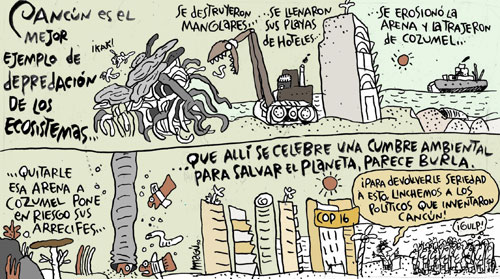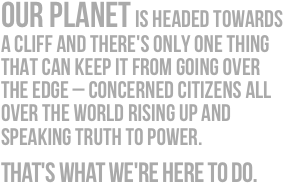-by Moisés Flores Baca
In my History of Filmmaking class this past Fall term we got the opportunity to look at various films that are considered propagandistic, including a few by the famous german filmmaker Leni Riefenstahl, who worked during Hitler’s regime being one of his favorite people.
When we think of the Nazi regime normally nothing positive comes to mind. This is why it came as a big surprise, not only to me but also to many of my classmates, that there was something about Riefenstahl’s films, especially one that shows a big Nazi youth summit, that made Nazism look as something good, as something great to look up to. In retrospective I figure that the fact that we felt in such way while watching the film has nothing to do with Nazism being in anyway positive, but with Riefenstahl’s ability to show it as something good.
When I was there at the first plenary of the COP16, feeling that I was before something “irresistible” -to word it somehow-, feeling the power there is in watching the faces of the negotiators blown-up a hundred times on the three different projections shown, made me consider the possibility that we were just being brainwashed and that we would continue to be for the next two weeks. It made me think about the footage that will be shown in media after the conference is over, trying to make seem what happened as something incredibly positive: we would see the youth carrying out actions, promoting “green” values and practices, and they will be smiling, dancing, having fun, just like the youth shown in the Riefenstahl’s movie are shown playing, having friendly wrestling matches, loving it all throughout; we would see the faces of the negotiators whose statements would be considered to have been positive and change-seeking; we would see the faces of culturally and racially diverse politicians smiling at each other and shaking hands, and we would experience a feeling similar to the one produced by Riefenstahl’s propagandistic Nazi movies: that what we are seeing is great and that we should look up to it.
The fact that environmentally-aware people are trying to tell others how they should live makes many believe that the environmental struggle is a new kind of fascism that is looking to step over people’s freedom to do whatever they want in the way they want. In my view this perspective is completely wrong for one main reason, that can be illustrated by the following comparison: on the one hand behind the Nazi ideology there was the believe of the superiority of the so-called “aryan race”, that supposed superiority implied that they were the only ones that deserved to survive. Putting aside economic considerations(the Jewish population was concentrating a lot of wealth supposedly taking away what belonged to the ‘real Germans’) it is fair to argue that the defended superiority of the “aryan race” was the main reason why the Jewish population of Germany and other some other European countries was hunted down. On the other hand, behind the “environmental ideology”, if we can call it so, there is the believe that in order to prevent terrible disasters that would take the lives of millions of people around the world, it is imperative that we change the way everyone lives (the level of radicalism of that change varies from person to person, from country to country, from organization to organization, etc, but the idea of the necessity of change is there). Environmentally aware people, by and large (sorry for the generalization) do not consider other groups of people inferior, do not consider that others should perish, on the contrary, they want even those who oppose their views to not be vanished by climate change. Yes, at certain level they are telling other people how to behave, however, they do it because they care for those people. It is like when the mother tells the children not to do something that might hurt them.
I think we should really think about whether freedom should be put on top of everything else, even if doing so compromises the survival of many, and the acceptable or high standards of living of many others. This is for the readers of this blog to poder around, especially those who sympathize with the idea that the environmental movement is fascist.




